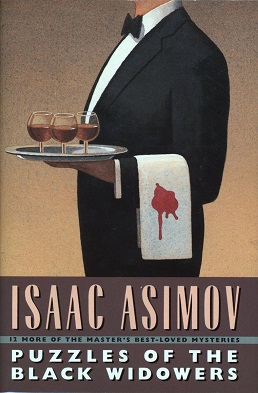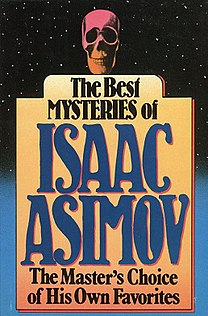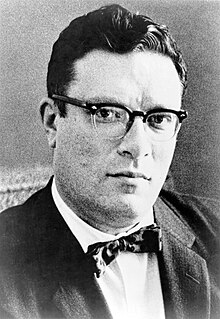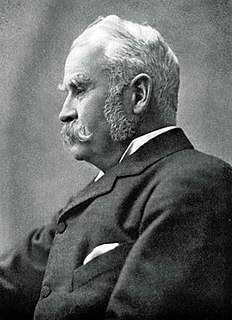See also: Isaac Asimov bibliography (categorical), Isaac Asimov bibliography (chronological)

Murder at the ABA (1976) is a mystery novel by American writer Isaac Asimov, following the adventures of a writer and amateur detective named Darius Just, whom Asimov modeled on his friend Harlan Ellison. While attending a convention of the American Booksellers Association, Just discovers the dead body of a friend and protégé. Convinced that the death was due to murder, but unable to convince the police, Just decides to investigate on his own.
Donald Roynald Bensen, known also as Don Bensen and listed sometimes as D.R. Bensen, was an American editor and science fiction writer. As an editor he is known best for editing works of P. G. Wodehouse and his involvement with their re-issue as paperbacks in the United States. As an author, he is known best for his 1978 humorous alternate history novel, And Having Writ..., published first by Bobbs-Merrill company.

Tales of the Black Widowers is a collection of mystery short stories by American author Isaac Asimov, featuring his fictional club of mystery solvers, the Black Widowers. It was first published in hardcover by Doubleday in June 1974, and in paperback by the Fawcett Crest imprint of Ballantine Books in August 1976. The first British edition was issued by Panther in 1976. The book has also been translated into German.

Banquets of the Black Widowers is a collection of mystery short stories by American writer Isaac Asimov featuring his fictional club of mystery solvers, the Black Widowers. It was first published in hardcover by Doubleday in September 1984, and in paperback by the Fawcett Crest imprint of Ballantine Books in June 1986. The first British edition was issued by Grafton in August 1986.

Casebook of the Black Widowers is a collection of mystery short stories by American author Isaac Asimov, featuring his fictional club of mystery solvers, the Black Widowers. It was first published in hardcover by Doubleday in January 1980 and in paperback by the Fawcett Crest imprint of Ballantine Books in March 1981.

More Tales of the Black Widowers is a collection of mystery short stories by American author Isaac Asimov, featuring his fictional club of mystery solvers, the Black Widowers. It was first published in hardcover by Doubleday in October 1976, and in paperback by the Fawcett Crest imprint of Ballantine Books in November 1977. The first British edition was issued by Gollancz in April 1977.

Puzzles of the Black Widowers is a collection of mystery short stories by American author Isaac Asimov, featuring his fictional club of mystery solvers, the Black Widowers. It was first published in hardcover by Doubleday in January 1990, and in paperback by Bantam Books the same year. The first British edition was issued in hardcover by Doubleday (UK) in April 1990, and the first British paperback edition by Bantam UK in April 1991.

The Return of the Black Widowers is a collection of short mystery stories by American writer Isaac Asimov, featuring his fictional club of mystery solvers, the Black Widowers. It was first published in hardcover by Carroll & Graf in December 2003, and in trade paperback by the same publisher in November 2005.

The Union Club Mysteries is a collection of mystery short stories by American author Isaac Asimov featuring his fictional mystery solver Griswold. It was first published in hardcover by Doubleday in 1983 and in paperback by the Fawcett Crest imprint of Ballantine Books in 1985.

The Best Mysteries of Isaac Asimov is a collection of mystery short stories by American author Isaac Asimov. It was first published in hardcover by Doubleday in 1986, and in paperback by the Fawcett Crest imprint of Ballantine Books in September 1987.
"The Acquisitive Chuckle" is a mystery short story by American writer Isaac Asimov in 1971, first published in the January 1972 issue of Ellery Queen's Mystery Magazine. He originally called it "The Chuckle", but the magazine's title was kept in subsequent uses of the story. It was the first of Asimov's stories about the Black Widowers, an eccentric group of men who met once a month. The story is based loosely upon the Trap Door Spiders, a stag-club of which Asimov was a member.
"Ph as in Phony" is a mystery short story by American writer Isaac Asimov. It was first published in the July 1972 issue of Ellery Queen's Mystery Magazine under the title The Phony Ph.D. The reason for this title change was that the magazine ran a series by Lawrence Treat with similar "_ is for _" titles. When it was republished in Tales of the Black Widowers in 1974, the original title was restored. It is the second published story about the Black Widowers, a gentlemen's club that solves mysteries based loosely upon the Trap Door Spiders, a stag-club of which Asimov was a member. It was reprinted in the collection The Return of the Black Widowers in 2003.
"The Ultimate Crime" is a short story by Isaac Asimov, dealing with a minor aspect of one of the Sherlock Holmes stories of Sir Arthur Conan Doyle. It is the 24th of Asimov's Black Widowers mystery stories, and it appeared in his anthology More Tales of the Black Widowers, which collects the second dozen stories of the series. It was written specially for that book. It subsequently appeared again in Sherlock Holmes Through Time and Space, an anthology of stories written by different authors and co-edited by Asimov, and Another Round at the Spaceport Bar.
In a writing career spanning 53 years (1939–1992), science fiction and popular science author Isaac Asimov (1920–1992) wrote and published 40 novels, 382 short stories, over 280 non-fiction books, and edited about 147 others.
Truth to Tell is a 1972 short story by Isaac Asimov. It is one of Asimov's series of stories about the Black Widowers, a gentlemen's dining club that meets monthly to solve mysteries and puzzles. It was first published in the October 1972 issue of Ellery Queen's Mystery Magazine under the title "The Man Who Never Told A Lie", and was included in the 1974 collection Tales of the Black Widowers.
Depending on the counting convention used, and including all titles, charts, and edited collections, there may be currently over 500 books in Isaac Asimov's bibliography— as well as his individual short stories, individual essays, and criticism. For his 100th, 200th, and 300th books, Asimov published Opus 100 (1969), Opus 200 (1979), and Opus 300 (1984), celebrating his writing.














